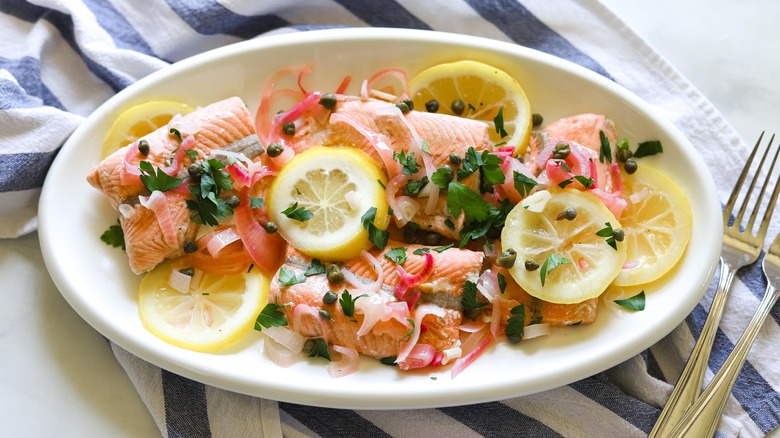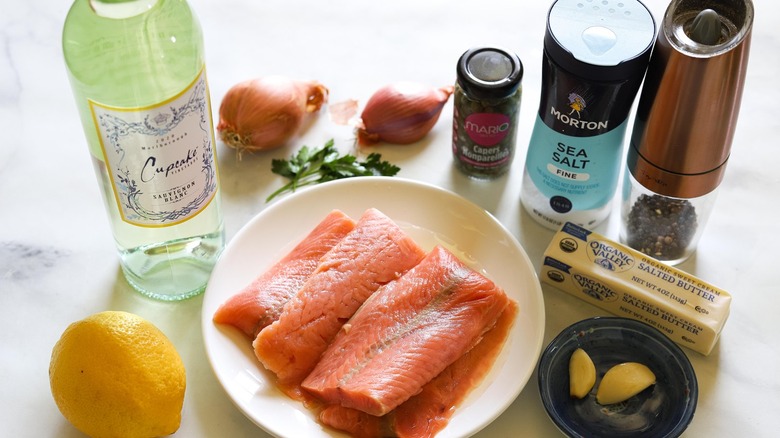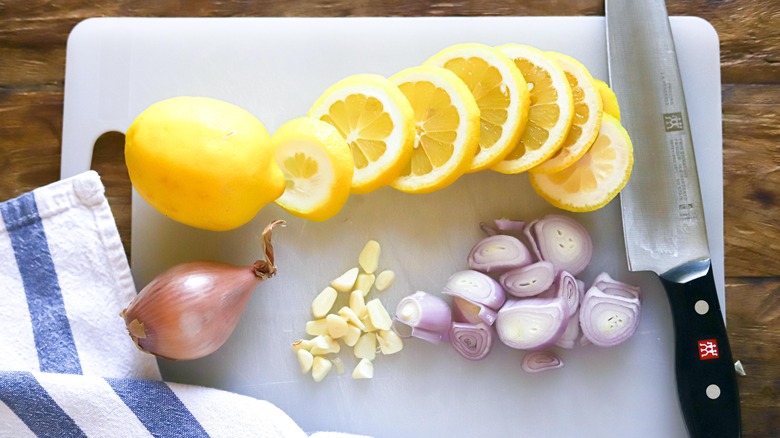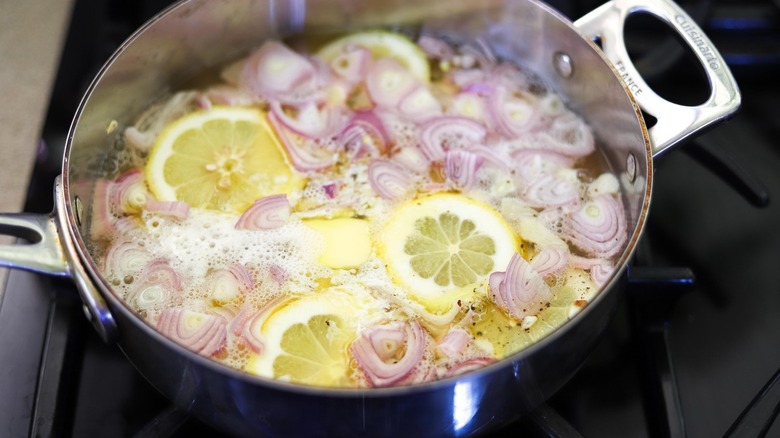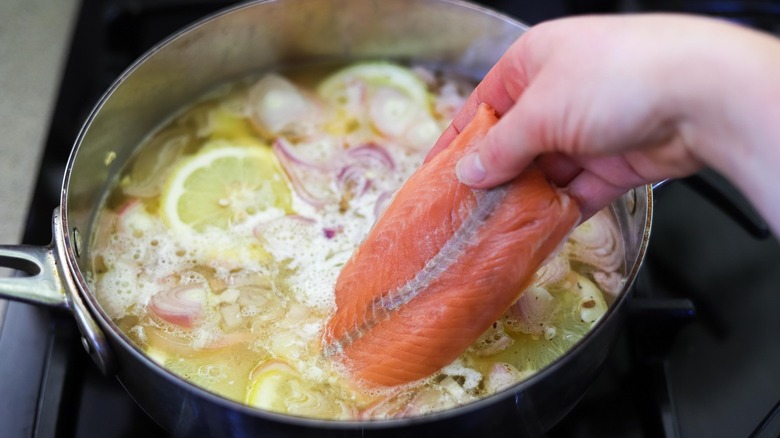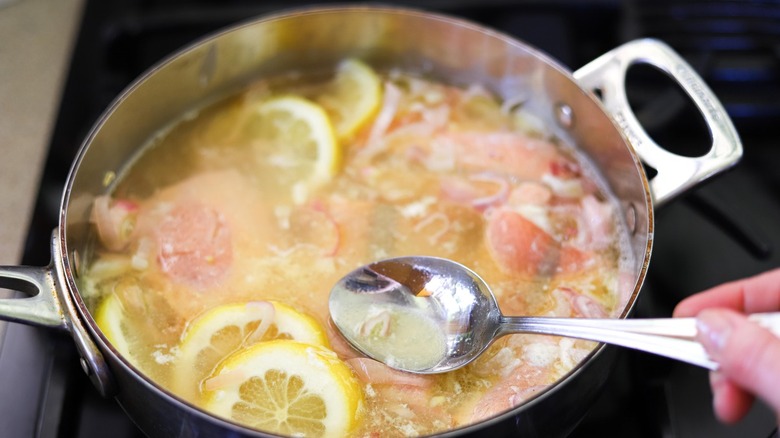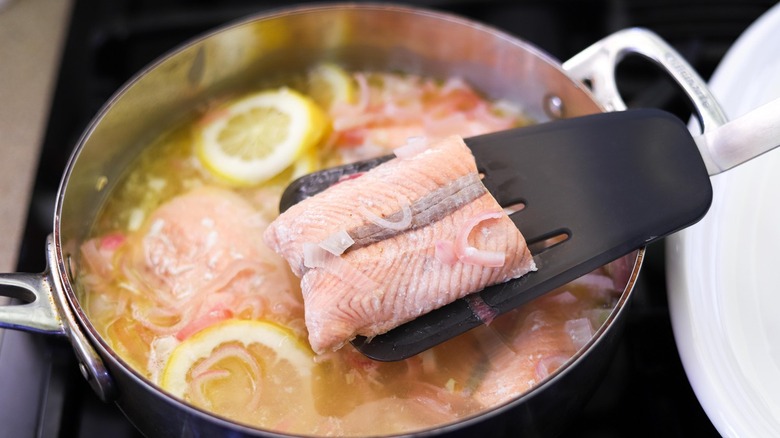Easy Poached Salmon Recipe
Poaching a salmon filet is nothing like poaching eggs, so it's unfortunate that the name gives everyone that impression. The difference between the two dishes is eggs are poached in water (and possibly a splash of white vinegar), whereas salmon is poached in a flavorful broth. Well, at least that's how recipe developer Kit Hondrum of Kit's Kitchen poaches her salmon, and she's shared her favorite recipe for the delicious seafood recipe here with us at Mashed. Hondrum's version of poached salmon is simmered in a wine-based broth that's infused with freshly sliced shallots, garlic, and lemon. "This is my favorite way to cook salmon!" she says, because it's "so easy and turns out perfectly every time."
Hondrum suggests to serve this delicious dish with a basic salad "for a no-fuss weeknight dinner," or place the poached salmon on top of freshly prepared linguine "for a date night." And if by chance you have any leftovers, they will make a superb second day meal served over a big green salad or alongside cauliflower rice. You can even prepare your salmon on a sandwich along with a dill mayo spread with chips on the side.
This poached salmon recipe makes a really impressive presentation, and your family or friends will absolutely enjoy having it for dinner. So, let's get into how you can make it in your own kitchen ASAP.
Gather your ingredients to prepare this easy poached salmon recipe
To make Hondrum's easy poached salmon dish, you'll need, for starters, four 6-ounce salmon fillets. Hondrum chose salmon fillet as opposed to salmon steak because the steak, which "is cut in a cross-section from the whole fish," offers a structured, meaty texture, which makes it a great choice to prepare on the grill. The salmon fillet, which Hondrum says is cut from along the salmon's side, comes out incredibly tender and flaky when poached.
Take note that between 20 and 30 minutes before you are ready to poach your salmon, you should remove your salmon fillets from the refrigerator. Doing this will allow the cold fillets to come closer to room temperature, and that will help them to cook evenly and all the way through. Just be sure to not take the salmon out of the fridge too soon, according to City Fish Market, because that could lead to a potential health hazard (by allowing bacteria to grow).
In addition, for the poaching broth, you'll need 2 cups of dry white wine, ¼ cup of water, two shallots, two garlic cloves, one lemon, 2 tablespoons of butter, 2 teaspoons of fine sea salt, and ¼ teaspoon of freshly ground black pepper. Optional ingredients are capers and fresh parsley chiffonade as garnish. Garnishes always make the meal look so great when it's ready to serve, so it's always worth the extra effort.
Prep your fresh ingredients
As soon as you take the salmon out of the refrigerator, you should begin to prep the fresh ingredients that will help flavor your poaching broth. To do so, you will have to peel the shallots and the garlic cloves, and toss out the skins. On a cutting board, and using a nice, sharp paring knife that fits comfortably into your hand, slice the shallots vertically in half, and then slice those halves thinly. Do the same step with the garlic cloves. As far as the lemon is concerned, wash the skin, and slice all the way through into six or seven cross-wise disks.
Now it's time to put the ingredients for the poaching broth together
After you have prepped the shallots, garlic, and lemon, it's time to put the broth together, and get to the poaching step. First, pour the wine and the water into a large skillet (at least a couple of inches deep). Then, add the sliced shallots, garlic, and lemon, as well as the butter, salt, and pepper. Turn the heat to medium-high. When you see the broth beginning to boil (as shown in the above photo), you'll want to reduce the heat to below a simmer. Shortly, you will be sliding the salmon filets into the poaching liquid.
Slip the salmon fillets into the poaching broth, and get poaching
With the poaching just below simmering, gently slip the salmon fillets into the liquid, but try to avoid having them rest directly on any of the lemon slices. Increase the heat just slightly, because the salmon will have reduced the temperature of the broth a bit. As the broth reaches a point just below a simmer, you should be able to see a few bubbles rising from under the fillets. That's when you should set a timer for eight to 10 minutes, depending on the thickness of your fillets (judge by the thickest point).
Stay by the skillet's side as the salmon poaches, because there's a bit of nurturing you'll need to do
Although it might be tempting to walk away from the stove as your salmon gently poaches, absorbing the delicious flavor of the poaching broth, it's best to remain beside the stove to make sure the heat doesn't get too high and to periodically baste any portion of the fillets that are not covered by poaching broth. Simply spoon some of the poaching broth gently over the filets. This will help ensure the salmon is cooked all the way through. Your kitchen will start to smell completely delicious right about now, and your pan will make you look and feel like you a pro chef.
Remove the cooked salmon from the poaching liquid
After your timer tells you that the eight to 10 minutes have gone by, take out a long articulated spatula with slats (for draining), and use it to transfer the now-poached fillets onto a serving platter or onto individual plates. You can also use the slatted spatula to transfer some of the shallots, garlic, and lemon slices to your platter or serving plates. The poaching liquid can be discarded, or you can put it in a mason jar, refrigerate, and use it to make risotto in the next day or so.
You did it! Now it's time to serve your delicious poached salmon fillets. They can actually be served warm or cold — it's totally up to you. Sit back, pour yourself and your dinner guests some white wine, and enjoy!
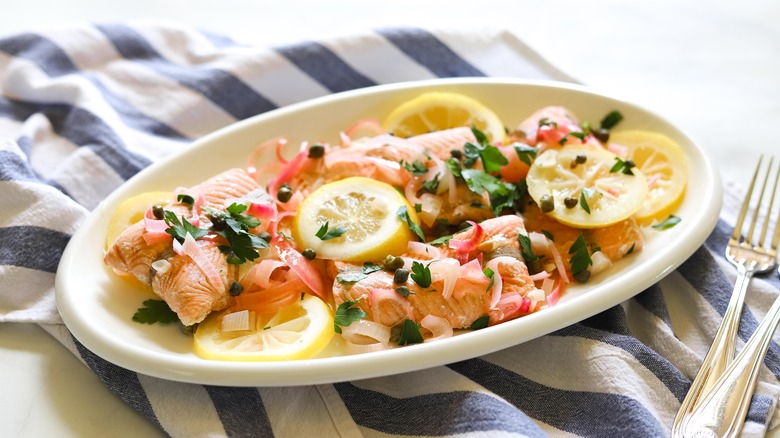
- 4 salmon fillets (about 6 ounces each)
- 2 shallots, sliced
- 2 garlic cloves, sliced
- 1 lemon, sliced
- 2 cups dry white wine
- ¼ cup water
- 2 tablespoons butter
- 2 teaspoons fine sea salt
- ¼ teaspoon freshly ground black pepper
- parsley, for garnish
- capers, for garnish
- Remove the salmon fillets from the refrigerator 20 to 30 minutes before cooking.
- Slice the shallots, lemon, and garlic.
- Place the wine and water with the sliced shallots, lemon, and garlic, as well as the butter, sea salt, and pepper to a large skillet.
- Bring to a boil over medium-high heat, then reduce to just below a simmer.
- Slip salmon fillets into the broth, and increase the heat to reach a simmer.
- Set a timer for 8 to 10 minutes, depending on fillet thickness.
- Baste any part of the fillets that are not covered by poaching liquid periodically throughout the cooking process.
- When the timer is up, remove the fillets with a long spatula.
- Serve warm or cold, accompanied as desired by the cooked shallots, garlic, and lemon. If desired, garnish with fresh parsley chiffonade and capers.
Nutrition
| Calories per Serving | 529 |
| Total Fat | 28.7 g |
| Saturated Fat | 8.8 g |
| Trans Fat | 0.2 g |
| Cholesterol | 108.8 mg |
| Total Carbohydrates | 10.0 g |
| Dietary Fiber | 1.4 g |
| Total Sugars | 3.8 g |
| Sodium | 826.3 mg |
| Protein | 35.9 g |
